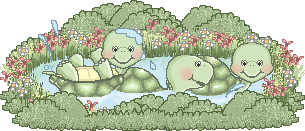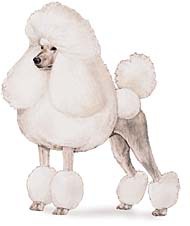
After purchasing your first Poodle, there are some simple procedures
for keeping him/her in top condition. Please read on:
At 8 weeks of age
your puppy should already have its feet, face and base
of the tail clipped. This should be done every 4 weeks until the pup is 6 months
old. This enables the pup to become accustomed to the feel and noise of the
clippers. Ears should be plucked at this time and also the nails should be trimmed.
Check ears weekly and clean them with a good ear cleaner. As an adult, it is
recommended that Poodles be clipped every 6 to 8 weeks. If you prefer your Poodle
to have a longer coat, their face and feet may need to be trimmed
more regulary
as the hair needs to be kept away from the eyes. The feet will need to
be
checked for grass seeds etc. between toes and pads (long foot fur also make messy
foot prints in the
house when wet).
Brushing with a slicker brush every day while the pup is young will get him into
a routine and will keep him knot free. Run a steel comb through the coat after
brushing just to be sure no knots were missed. As an adult, thorough grooming
three times a week is sufficient.
Gooming and removal of knots
is essential BEFORE bathing. When brushing, part
the coat and brush from the roots out. Poodles DO MOULT, but they do not
drop
their hair. When they moult they need to be brushed more regularly, otherwise the
dead hair stays in the coat and will become matted. Always ensure ALL shampoo and
conditioner is rinsed out good, otherwise dandruff will occur and may make the dog itch.
If your puppy objects to brushing, you must persist and be consistent
(just as for toilet training ). Place your puppy on a table and spend a few minutes
every day and don't stop because he's trying to bite or yelps, as this is his way of
teaching YOU! He will soon learn that the job gets done quicker when there's no fuss.
Always remember to praise when he has been good. Do not play with the pup while he
is on the table, otherwise he will not understand the difference between playtime and
groom time.
A common thought amongst pet owners is that a poodle should be kept long during
the winter because "he will get cold". This is okay if you are prepared to do the
work to keep his coat knot free. If you prefer a short, maintenance free cut for
your poodle, it is best to be short all year round as the body will adjust to the
changing weather. Doggy jumpers come in handy for your shorthaired Poodle when
you go out in the weather, BUT can cause the long coat to matt twice as fast.
The puppy's coat is very different from the adult Poodle course, curly coat. It is
straighter, fuzzier, tends to matt heavily and doesn't hold a trim. Poodle pups
often look best in a full coat with clipped face, feet, and tail.
>Touch your new puppy's feet and rub your fingers between its toes a couple times
a day. This will make nail clipping easier.
>Show your puppy the brush. Let it sniff and play with it for a few seconds.
Brush it's coat a few times, then reward your puppy with a small treat and
verbal praise. Each day increase the number of brush strokes.
>Handle your puppy's ears, then reward with a treat and praise. A puppy's ears
are more tender than an adult Poodle. They will usually whine the first few times
when hair is plucked from the ear.
>Bath your puppy with a mild puppy shampoo. Fill the sink or tub to a depth that
will get only your puppy's feet wet. Give your puppy time to get used to the water.
Add more water to get the puppy's legs and body wet. Wet it's head last.
Brushing your Poodles Teeth is crucial in maintaining your Poodle's good
heatlh.
Many people forget how important dental care is for their pet until the periodontal
disease has set in and serious dental work is required. The key to avoiding
periodontal
disease and other health challenges is to start brushing your Poo's teeth as soon as
possible and frequently as possible. Time invested towards your poo's oral hygiene
throughout his life will certainly help keep your poo happier and healthier.
Whether you're starting to brush your poo's teeth at a young age or an older age,
you should start the process slowly.
Open your puppies mouth and touch its teeth and gum. You can begin by using a
finger brush or puppy toothbrush
and toothpaste made for dogs.
NEVER use human toothpaste on your dog. Human toothpaste is too abrasive on your
poo's teeth and contains fluoride that should not be swallowed.
When you feel your puppy is ready, add a little toothpaste to the toothbrush and
allow him to have a taste. When your puppy is finished, don't forget a treat !
After your puppy has succeeded in tasting the toothpaste on three or four
occasions,
attempt to brush his teeth in a circular, massaging motion, starting at the back molars.
After every few strokes, give your puppy a treat and continue if your puppy remains
comfortable. Brush all of the teeth on the outside, inside and top. Brush his teeth on
a regular basis.
Good dental health begins with the proper diet!
The wrong kinds of food can cause dental distress in dogs. Feeding your dog a dry
food rather than a moist canned one will helps remove the bacterial plaque that can
harden into tartar. Dry food also provides adequate chewing exercise and gum
stimulation. Avoid giving your dog sweets and table scraps as they may also increase
plaque and tartar formation.
Chew treats, including hard meat-protein biscuits and Deer Antler Chews for dogs,
can help remove plaque, and provide stimulation for the gum.
Watch out for wood - throwing sticks can result in splinters and gum damage.
Don't let your dog chew on hard materials like bones or stones.They can wear down,
even break teeth, damage gums and lead to infection.
Almost all poodles have weepy eyes. There are very few dry-eyed poodles
out there. This is not a result of poor breeding or indicative of a sick
dog. It is
just a fact of life with the poodle breed in general. The weepy eyes are due to
the tear ducts being too small to accommodate the tears the eye
produces. There
is a surgery that can correct this, but the cost is prohibitive. Most people learn to
live with it. Cleaning is required to prevent fur staining and to keep odor down.
Cleaning also prevents eye infections like pink eye-conjunctivitis. We recommend daily
cleaning of the eyes with nonalcoholic free baby wipes, a wet cloth, or pet eye wipes.
There are lots of products out on the market that claims
to reduce or eliminate the
rust colored sins around the eyes. I have
yet to find one that works. Most of the
time it is the shaving of the face that removes the stains. That is until the eye starts
to weep again.It seems to be an
endless process.
Ears need to e kept clean and free of hair. It you detect a foul odor from
the ears this means TROUBLE !!! The hair needs to be plucked. Make sure
your
groomer cares for the ears properly. Be sure to keep water out of the ears when
bathing your pet. If your poodle scratches its ears a lot and cries then you may
have a problem. Always check the ears for Ticks and Mites. Ear mites
are
microscopic pests that take up residence in
your dog's ears. The ears become
inflamed, sore and itchy. You may see your dog shaking his head a lot as well as
the scratching. This problem is very easy to pass from one dog to another but is
also easy to clean up with insecticide ear drops. If unsure whether your dog has
ear mites, check with your vet or groomer. Ear mites can also be detected by
swabbing the ear canal with a Q-tip (do not worry you can not hit the ear drum)
and then rubbing the swab on a piece of black paper.
The mites will appear as
tiny white moving dots. Do not panic! You can obtain ear mite drops a most any
store that carries dog supplies.
Flea Pest Control
First Step in Flea Pest Control is a Bath
When you suspect your
pet has fleas the first step is the direct approach.
Attack the fleas where they live with a 1 to 1
combination of Dawn dish soap and white
vinegar. You can use apple cider vinegar if you like
and this may add some nutrition for
your pets skin. Important! Before starting the bath spray some vinegar on your pet's
head; everywhere except its eyes and nose. This will
keep the fleas from relocating to
the head when you start the bath.
Soak your pet with warm water then apply the
vinegar/soap solution. Work it into a rich lather
making sure it penetrates to
the skin
and gives your pet a thorough scrubbing.
(Obviously you will want to make sure you avoid
your pets
eyes) The duration of your pet's bath should be at least
15 minutes to make
sure that the fleas have been exposed to the vinegar
long enough to have an effect on
them. Rinse the soap out and you are
done. The vinegar smell will disappear once it dries
but if you prefer you can follow up with your standard
pet bath and rinse to remove it.
This of course will extend the process and your pet may not appreciate it. Your call!
Periodic Skin Treatments
After bathing, it would
be a good idea to continue your attack with some weekly or
bi-weekly skin treatments to add to your flea pest
control regime. Make another 1 to 1
solution, this time using white vinegar and water in a
spray bottle. Spray this solution all
over your pet's body and work it down to the skin
using your fingers. Avoid the eyes as
vinegar will sting.This is a continuation/modification of the bathing process and is done
to ensure surviving fleas are dealt with before they are able to regain their foothold.
Depending on the thickness of the hair you may find it
easier to use a pet comb or brush
to get the solution down to the skin where it can do
its work. Having completed your
direct attack on the flea pest control problem it is
time to take a less direct approach.
It is time for some maintenance.
Vinegar in the Wash
When your pet gets fleas some of them will likely take up residence in Fido's bedding.
You don't want to
reintroduce the problem to your freshly washed pet so his/her bedding
should also be washed.
Add 1/2 a cup of white vinegar (don't waste the apple cider vinegar)
to your wash and get that bedding clean.
In fact
you may want to do this for your bedding
as well just to be safe.
Don't Forget Your Furniture and Carpet
Spraying your furniture
and carpets with the 1 to 1 solution of vinegar and water should
help with your flea pest control efforts. If you
decide to use a carpet cleaner you may want
to use a vinegar/water solution as one of the washes
but I don't recommend adding vinegar
directly to the carpet cleaning solution as it may
have unpredictable results.
















